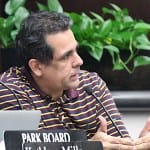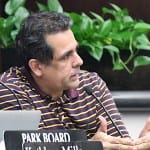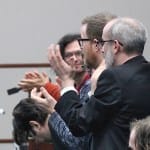Protest at Bloomington park board meeting yields 2–1 vote on farmers market rules of behavior



Bloomington’s board of park commissioners voted 2–1 on Tuesday night to adopt new rules of behavior at the city’s farmers market. Dissenting was the newest board member, Israel Herrera.
The rules specify how and where protests are allowed at the farmers market.
Herrera told The Square Beacon after the meeting that his vote was based on the concerns that meeting protestors had conveyed—from the public podium and their seats in the audience—about the possibility of increased police violence in the coming season, due to the new rules. People who speak up should not be forced to shut up, he said.
The 2–1 tally was enough to pass the measure on the four-member board. One seat is currently vacant. The city’s corporation counsel, Philippa Guthrie, told The Square Beacon the board needs a majority of those present to approve a motion.
The proposed new rules have drawn criticism from market protesters since mid-December last year when they were introduced to the farmers market advisory council.
Tuesday’s meeting protesters included members of the self-monikered Purple Shirt Brigade, who conducted protests at the market last year against Schooner Creek Farm, a farmers market vendor whose ties to white supremacist groups were identified last summer.
Not all the voices in the room belonged to meeting protesters. Based on applause at the meeting for one public speaker, who urged adoption of the rule as a fair compromise, the rules had a lot of public support.
The adopted new rules include new wording with prohibitions against “picketing,
demonstrating, yelling, excessive or unreasonable noise-making, obstructing or
hindering the flow of pedestrians or access to a vendor, and other conduct
disrupting Market activities.”
The new rules also include a reference to a parks department administration policy, which the board also amended at Tuesday’s meeting, on a 3-0 vote. The amendment to the administrative policy added one sentence: “Any person who is asked to leave by a law enforcement officer as defined by Indiana Code and refuses to do so may be subject to arrest.”
The new rules, in conjunction with the amended policy, one meeting protestor said, would increase the likelihood of police violence.
That drew a question from park commissioner Herrera. He wanted to know why the meeting protesters thought the new rules would increase police violence.
The explanation offered to Herrera was based on the arrest of an Indiana University history professor last July—she was holding a sign, protesting white supremacists, outside one of the designated areas for demonstrating at the farmers market.
That incident now appears headed for litigation, based in part on a false arrest claim, because the previous rules were adopted by an ad hoc committee.
Enacting the administrative policy in conjunction with the new rules would prevent anyone in the future from asking for justice based on a false arrest claim—that’s the argument made by the meeting protester. “The only way violence will not happen in that situation is if the person who is exercising their free speech self-censors themselves and chooses to stop,” was the explanation from the protestor at the public podium.
The way the new rules of behavior relegate protest activity to restricted areas around the market was a point to which protesters objected. Board chair Kathleen Mills said based on her own experience in protest movements, she understood the desire to be just “inches away” from the thing you’re trying to protest. But Mills felt that the available areas designated for protests were enough. She said that if protests were allowed in the vendor area, it would make for a “free-for-all.”
On Tuesday, meeting protesters used a technique that could be described as a kind of citizen’s filibuster. The administrative policy and new rules of behavior were items 15 and 16 listed under “other business” on the board’s agenda. A half dozen protestors rose to comment for the allowed two minutes on each of the first few items. Varying from speaker to speaker was the closeness of the connection between the commentary and the topic of the agenda items.
After a few rounds of commentary, board chair Kathleen Mills paused to address the issue by saying she was not certain what the goal was for the protestors. She imagined that one possible goal might be to cause enough delay that the board did not reach the two items at the end of the agenda.
Mills allowed that sometimes the goal of a protest can simply to be annoying. About that tactic, Mills said, “I’m a high school teacher, I can do annoying all day long.”
Based on protestor comments, the point of their protest technique appeared to be to hammer home the idea that every piece of business the park board handles has an impact on racism one way or another. One meeting protestor said she understood the board wanted to complete a lot of business that night, but added, “It’s all impacted by racial justice.”
Mills called for a brief recess, during which commissioners, parks staff and legal staff huddled behind the dais. The play Mills called when they returned was to move the two controversial agenda items up for immediate consideration.
Changing the agenda order was a decision that was met with vocal opposition from meeting protesters. They said it was against the rules to change the published meeting agenda order. Mill said the city’s legal department had assured her that it was allowed to change the order of meeting agenda items.
It’s not unusual for public bodies to change the order of an agenda, sometimes by changing the order at the start of the meeting. Or they can table an item, handling other items first, and then take up the tabled item later. But one protestor questioned whether the reason for the change in agenda order was motivated by the content and viewpoint of the speech by protesters.
The board’s decision to change the order of the agenda fit into another theme that meeting protesters adopted—”following the rules.” City officials wanted the protestors to follow the market rules and the board meeting rules, but city officials themselves were not willing to follow their own rules, protesters said.
On Tuesday, a couple of meeting protesters pointed to a Jan. 9 meeting, when the board voted to maintain city control of the market, as an example of the board not following its own rules, with respect to public speaking time.
On Jan. 9, one public speaker, Charlotte Zietlow, was allotted around five minutes compared to the three minutes given to others. When she rose to speak, commissioner Les Coyne, who chaired that meeting, introduced the 85-year-old Zietlow, after whom Monroe County’s justice center is named: “I’d very much like to welcome the esteemed Charlotte Zietlow who needs no introduction.” Zietlow quipped, “Then I won’t introduce myself.”
When the three-minute beeper sounded, Zietlow asked, “Is that the time?” Coyne replied, “Keep going, please,” adding, “This is a unique person who has contributed a great deal to this community.”
On the topic of racism, one meeting protestor on Tuesday drew a distinction between racists and racist policies. He told park commissioners he didn’t think they were racists when it’s defined as “as an individual person who harbors feelings of racial hatred in their hearts.”
But he called that definition “problematic,” and told commissioners, “The policy that you’re about going to enact is a racist policy.” The outcome of the policy would be racist, he said: “I all but guarantee you’re creating an all-white market.”
The same protestor pointed out that Black Lives Matter (BLM) had called for a boycott of the city’s farmers market. About the audience at the board meeting, he asked: “Where are the Black leaders of Bloomington? Why do they feel unwelcome here? It’s the same reason they don’t feel welcome at the market,” he said. Black leaders in Bloomington “have written you off,” he said.
The one Black member of Bloomington’s nine-member city council, Jim Sims, told The Square Beacon he supports the BLM position on boycotting the farmers market. “I support the farmers market boycott call, and I will not visit the farmers market as long as known white supremacy advocate are vending…” Sims said that he would still sometimes visit the non-vendor market area known as Information Alley.
Sims said he also understands the reason for the other part of BLM’s call—for subscribers and advertisers to boycott the local paper, The Herald-Times. But he said, “I believe in a ‘free press’ and will not boycott the Herald-Times by canceling my subscription.” On the first Sunday of February, Black History Month, the paper published a sympathetic profile of the farmers market vendor against whom last season’s protests were conducted.
On Tuesday, one meeting protestor cited the State of the City speech given last week by Bloomington’s mayor, John Hamilton, as acknowledging Bloomington’s history of racial injustice.
Offering a chance for a vignette about segregation in Bloomington was another item on the board’s agenda—about the approval of a partnership agreement between the Buskirk-Chumley Theater and the city of Bloomington.
Two stories were told during public commentary of how the old Indiana Theater, now named the Buskirk-Chumley, was de-segregated.
The first story was that the Indiana Theater was integrated when the theater manager asked an Indiana University star football player, George Taliaferro, to visit the theater and sit in the downstairs section where Black patrons were not allowed. Taliaferro did that, and because of his status as a football player, his presence was accepted, which led to the integration of the theater.
An alternate view was presented on Tuesday by a different commenter, who said Taliaferro had in fact gone to the theater with a screwdriver and removed the sign that read “Colored” from the area where Black people were supposed to sit.
Both vignettes are described in Dawn Knight’s 2019 book “Race and Football in America: The Life and Legacy of George Taliaferro.” Based on the book, both stories are true. The episode involving the screwdriver involved the Princess Theater.
The Square Beacon counted at least four different Bloomington police officers who were in council chambers at some time during Tuesday’s meeting.
At one point, when the back-and-forth between commissioners and protesters grew heated, Bloomington’s corporation counsel Philippa Guthrie waved to two officers seated in the back of the room. They exited the city council chambers and re-entered through the other set of doors and positioned themselves off to the side. No arrests were made.
Click to view slideshow.



Comments ()